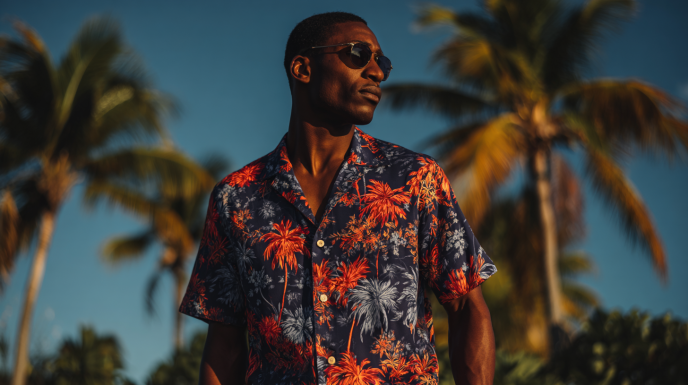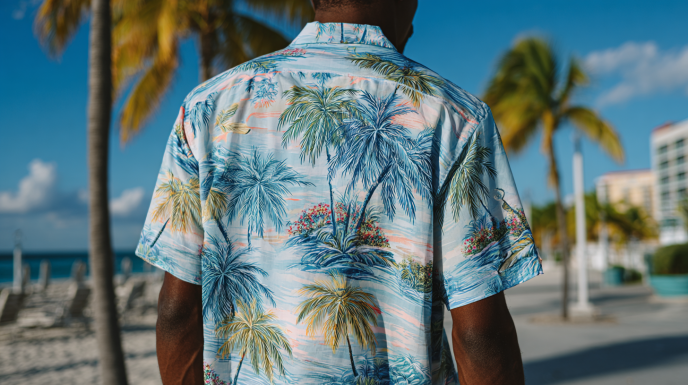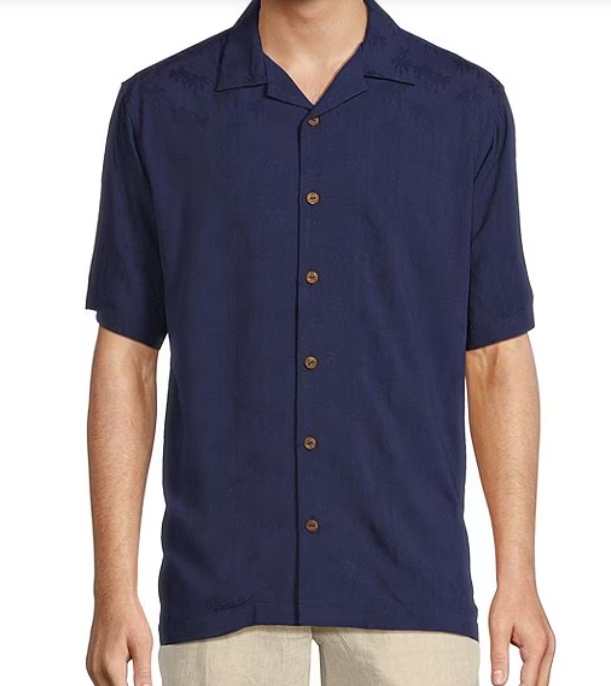
Caribbean Palm Trees Jacquard Short Sleeve Woven Camp Shirt
- Jacquard fabric
- Palm print
- Camp collar
- Short sleeves
- Button-front closure
- Straight hem
- Rayon
- Machine wash/tumble dry
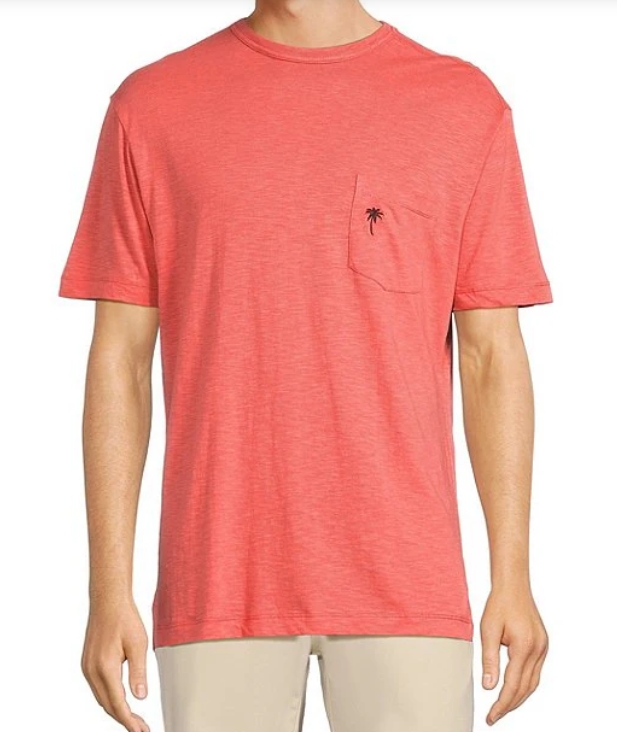
Caribbean Solid Short Sleeve Slub T-Shirt
- Solid tone
- Crew neck
- Short sleeves
- Patch pocket on the left side of the chest
- Relaxed fit
- Pullover construction
- Cotton/modal
- Machine wash/tumble dry
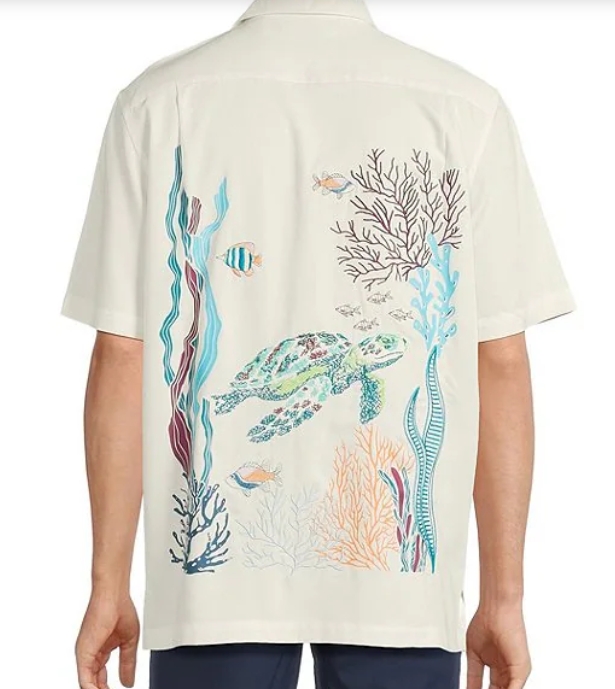
Caribbean Coral Reef Turtle Print Embroidery Short Sleeve Woven Camp Shirt
- Camp collar
- Short sleeves
- Button-front closure
- Coral fish patch pocket embroidery on the left side of chest
- Straight hem
- Playful mix of prints and embroidery on the back
- Rayon/lyocell
- Machine wash/tumble dry
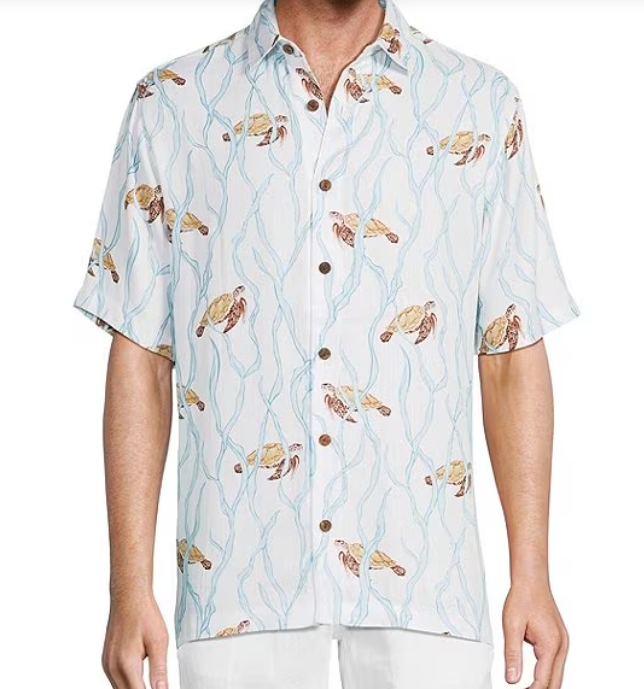
Caribbean Turtle Print Short Sleeve Woven Shirt
- Allover turtle print
- Point collar
- Short sleeves
- Button-front closure
- Straight hem
- Rayon
- Machine wash/tumble dry
Where Island Culture Meets Fashion Expression
Caribbean shirts aren’t just clothing—they’re wearable expressions of island heritage that have transcended their origins to become global style statements. From the shores of Jamaica to the beaches of Barbados, these colorful garments tell stories of cultural fusion, colonial influence, and tropical identity through their vibrant patterns and relaxed silhouettes.
As someone who’s spent years collecting and studying these distinctive pieces, I’ve witnessed firsthand how a simple shirt can transport you to sun-drenched shores even when you’re miles from the nearest beach. Today, I’m taking you on a journey through everything you need to know about these iconic garments—from their rich history to styling tips that will have you looking like you belong on a postcard from paradise.
What’s in a Name? Discovering the Guayabera and Beyond
Caribbean shirts go by many names, reflecting the diverse cultural landscape of the region itself. The most iconic is perhaps the guayabera—a formal shirt with distinctive vertical pleats and four front pockets that originated in Cuba but spread throughout the Caribbean and Latin America. Often called the “Mexican wedding shirt” or “Cuban shirt,” the guayabera represents a perfect blend of practicality and elegance.
In Jamaica, you’ll find the “bush jacket” or “kariba shirt,” while in the Dominican Republic, similar styles might be called “chacabanas.” Each island puts its own spin on these garments, incorporating local aesthetics and practical adaptations for the tropical climate.
Unlike their Hawaiian cousins (more on that distinction later), authentic Caribbean shirts often feature more subdued colors, intricate embroidery, and structural details that elevate them beyond mere casual wear. The variation in names reflects not just geographic differences but centuries of cultural exchange, migration, and adaptation.
Roots in the Colonial Era: The Fascinating History of Caribbean Shirts
The story of Caribbean shirts is one of cultural fusion and practical innovation. The guayabera’s origins date back to the 18th century, with competing narratives from Cuba and Mexico both claiming to be its birthplace. The most commonly accepted story traces the shirt to rural Cuba, where farmers needed practical garments with pockets large enough to carry guavas (hence the name “guayabera”) or small tools during their workday.
Spanish colonists adapted local designs, incorporating elements from their European garments while making practical modifications for the tropical climate. The result was a shirt that provided ventilation and utility while maintaining a certain formal appearance—a perfect combination for island life.
By the 19th century, these shirts had become symbols of cultural identity across the Caribbean. Each island developed variations reflecting their unique cultural influences—African, European, Indigenous, and later, Asian elements all contributed to the evolution of what we now recognize as Caribbean shirts.
During the mid-20th century, these garments gained international recognition when political figures like Cuba’s Fidel Castro and Mexico’s Luis Echeverría wore them at diplomatic events. This exposure transformed what had been primarily workwear or formal attire within the Caribbean into recognized fashion statements worldwide.
The Fabric of Island Life: Materials That Make the Difference
The magic of Caribbean shirts isn’t just in their designs but in the thoughtfully selected fabrics that make them perfectly suited to tropical environments. Traditional guayaberas were crafted from linen, a breathable natural fiber that allows air circulation while absorbing moisture—essential qualities in humid climates.
Today, you’ll find Caribbean shirts made from a variety of materials:
- Linen: Still the premium choice, offering exceptional breathability and a distinctive texture that develops character with age
- Cotton: More affordable than linen while still providing good airflow and comfort
- Linen-cotton blends: Offering the best of both worlds—the breathability of linen with the durability and lower cost of cotton
- Ramie: A lesser-known natural fiber similar to linen but with even greater resistance to bacteria and moisture
- Modern performance blends: Contemporary versions incorporating small percentages of synthetic fibers for wrinkle resistance and ease of care
The finest Caribbean shirts feature hand-rolled edges, French seams, and expert embroidery—details that separate authentic pieces from mass-produced imitations. The weight of the fabric matters too; traditional shirts use lightweight materials that float away from the body, creating natural ventilation.
Island artisans have historically favored natural, undyed fabrics that reflect the tropical sunlight, though modern interpretations embrace vibrant colors and patterns inspired by the region’s lush landscapes and diverse cultural influences.
From Plantation to Fashion Plate: Style Evolution
Caribbean shirts have undergone remarkable transformations over the decades. What began as practical workwear for field laborers evolved into formal attire for island gentlemen before becoming global fashion statements embraced by celebrities and style enthusiasts worldwide.
The classic guayabera features four front pockets, vertical alforzas (decorative pleats), and straight hemlines designed to be worn untucked. This traditional design speaks to its origins as a garment that balanced utility with presentability. Workers could carry small items in the pockets while maintaining a relatively formal appearance.
As these shirts evolved, regional variations emerged:
- Cuban guayaberas tend to be more formal, with elaborate embroidery and pleating
- Puerto Rican variations often feature more colorful designs and may incorporate indigenous Taíno symbols
- Dominican chacabanas may include additional decorative elements around the collar and pockets
- Jamaican styles frequently embrace brighter colors and more relaxed silhouettes
By the 1950s and 60s, these shirts had caught the attention of Hollywood, with stars like Ernest Hemingway and Gary Cooper sporting them in tropical locations. This exposure introduced Caribbean shirts to new audiences, setting the stage for their inclusion in contemporary fashion.
Today’s designers continue to reinterpret Caribbean shirts, blending traditional elements with modern cuts and patterns. High-end fashion houses have embraced the style, creating luxury versions that maintain the essential characteristics while introducing new materials and design elements.
Hawaiian vs. Caribbean: Understanding the Distinction
Though often confused with Hawaiian shirts (aloha shirts), Caribbean shirts represent a distinct style tradition with different origins and characteristics. While both emerged from tropical island cultures and reflect adaptation to similar climates, they developed along separate paths.
Hawaiian shirts typically feature bold, colorful prints of flowers, palm trees, and island scenes printed onto the fabric. They emerged in the 1920s and 30s, influenced by Japanese kimono fabrics and Western garment construction.
Caribbean shirts, particularly guayaberas, distinguish themselves through:
- Structural details like pleats and pockets rather than printed patterns
- More formal appearance and construction
- Emphasis on solid colors with decorative embroidery
- Straighter, more tailored silhouettes
- Cultural significance as formal attire in many Caribbean countries
Where Hawaiian shirts lean casual and playful, Caribbean shirts often carry greater cultural significance and formality. In many Caribbean nations, a well-made guayabera is appropriate for government functions, weddings, and business meetings—contexts where a Hawaiian shirt might be considered too casual.
That said, modern interpretations have blurred these distinctions somewhat, with contemporary designers creating Caribbean-inspired shirts that incorporate elements from both traditions. The key difference remains that authentic Caribbean shirts emphasize craftsmanship and structural details over printed patterns.
Finding Authenticity: Where to Purchase Genuine Caribbean Shirts
For those seeking authentic Caribbean shirts, sourcing matters. Mass-produced versions often miss the subtle details and quality construction that define genuine articles. Here are the best places to find the real deal:
Direct from Caribbean Artisans: Nothing beats purchasing directly from workshops in Cuba, Puerto Rico, the Dominican Republic, or Jamaica. These small-batch producers maintain traditional techniques and designs passed down through generations.
Specialty Boutiques: In cities with significant Caribbean populations—Miami, New York, London—you’ll find boutiques specializing in authentic island clothing. These shops often have direct relationships with artisans.
Heritage Brands: Companies like Cubavera, D’Accord, and Guayaberas Etc. have built reputations for maintaining authentic designs and construction methods while making Caribbean shirts more accessible to global customers.
Vintage Dealers: For collectors, vintage shops and specialized online dealers offer access to historical pieces that showcase how these garments have evolved over the decades.
When evaluating authenticity, look for key indicators of quality:
- Hand-finished details like rolled hems and precise pleats
- Natural fiber content (primarily linen or cotton)
- Proper construction of traditional elements like alforzas (pleats)
- Evidence of hand embroidery rather than machine work
- Proper weight and drape of the fabric
Beware of inexpensive imitations that might look similar at first glance but lack the craftsmanship and material quality that make genuine Caribbean shirts not just garments but cultural artifacts.
Beyond the Beach: Styling Caribbean Shirts for Every Occasion
The versatility of Caribbean shirts extends far beyond resort wear. These garments can be styled for occasions ranging from casual beach outings to formal celebrations. Here’s how to wear them appropriately across different settings:
Casual Daywear: Pair an untucked Caribbean shirt with linen shorts or chinos and leather sandals for a refined yet relaxed look perfect for lunch by the sea or exploring tropical towns.
Smart Casual: Combine a crisp, solid-colored guayabera with tailored trousers and loafers for an ensemble that works for dinner reservations or gallery openings. Add a Panama hat for an extra touch of island sophistication.
Business Settings: In tropical regions, a well-pressed long-sleeve guayabera in white, ivory, or pale blue pairs perfectly with dark trousers for business meetings. This combination is recognized as appropriate business attire throughout the Caribbean and parts of Latin America.
Formal Events: For weddings and celebrations, consider a traditional formal guayabera in white linen with French cuffs and decorative embroidery. This style has been acceptable wedding attire in the Caribbean for generations and offers a distinguished alternative to a conventional suit in hot weather.
Creative Layering: During transitional seasons, try wearing an open Caribbean shirt over a simple t-shirt or tank top, paired with jeans or chinos for a look that bridges casual and put-together.
The key to styling Caribbean shirts successfully lies in understanding their dual nature as both casual and formal garments. Unlike many Western shirts that are clearly categorized as either dressy or casual, Caribbean shirts occupy a unique position that shifts based on fabric, color, and details.
Caring for Your Caribbean Treasure: Maintenance Tips
Quality Caribbean shirts represent an investment in both style and cultural appreciation. Proper care extends their lifespan and maintains their distinctive character:
Washing Considerations: Most authentic Caribbean shirts should be hand washed in cold water with mild detergent. The delicate embroidery and natural fibers require gentle handling to preserve their integrity.
Drying Techniques: Air drying is almost always preferable to machine drying. Hang your shirt on a padded hanger in a shaded area—direct sunlight can fade colors and weaken natural fibers over time.
Ironing Secrets: Iron linen and cotton Caribbean shirts while slightly damp for best results. Use a medium-hot iron and press the decorative pleats carefully to maintain their definition. Some traditionalists use rice water starch for a crisp finish on formal guayaberas.
Storage Wisdom: Store on wooden or padded hangers rather than folded to prevent permanent creases. If you must fold for travel, roll rather than fold flat to minimize wrinkles.
Professional Cleaning: For investment pieces or shirts with elaborate embroidery, professional dry cleaning may be worthwhile. Ensure your cleaner has experience with delicate natural fibers and embroidered garments.
With proper care, a well-made Caribbean shirt can last for decades, developing a beautiful patina that tells the story of its journey with you. Unlike fast fashion items designed for brief use, these garments are created to become longtime companions in your wardrobe.
Cultural Significance: More Than Just Clothing
Caribbean shirts carry profound cultural meaning beyond their aesthetic appeal. They represent centuries of island heritage, resistance, and adaptation in the face of colonization, migration, and cultural exchange.
In Cuba, the guayabera became a symbol of national identity, with Fidel Castro’s adoption of the garment sending a powerful message about Cuban self-determination and rejection of Western corporate influence. Similarly, in other Caribbean nations, these shirts often served as visual assertions of local identity during and after colonial rule.
For diaspora communities, Caribbean shirts provide tangible connections to ancestral homelands. Wearing these garments at community gatherings and celebrations helps maintain cultural traditions across generations and geographic distances.
The shirts also tell economic stories—many Caribbean communities developed textile traditions as means of self-sufficiency and later economic development. Supporting authentic artisans continues this legacy, providing sustainable livelihoods that preserve traditional skills.
When wearing Caribbean shirts, it’s valuable to appreciate this deeper significance. These aren’t simply tropical novelties but expressions of cultural resilience and creativity that deserve respect and recognition.
Customization and Personalization: Making It Your Own
One of the most appealing aspects of Caribbean shirt traditions is the opportunity for personalization. Throughout the region, custom-made shirts remain accessible luxuries rather than extravagant splurges.
Traditional tailors in Havana, Santo Domingo, San Juan, and Kingston continue to offer made-to-measure services, allowing customers to select specific:
- Fabric weights and compositions
- Embroidery patterns and colors
- Pocket configurations
- Fit adjustments for individual body types
- Special details like monogramming or family symbols
This customization tradition extends to the contemporary market, with several heritage brands offering semi-custom options online. These services typically provide basic measurements and customization choices without requiring in-person fittings.
For those seeking truly unique pieces, working directly with Caribbean artisans during island visits provides the most authentic experience. Many workshops welcome visitors and can create bespoke garments within a few days—perfect for travelers seeking meaningful souvenirs.
The personalization aspect connects wearers to the handcraft tradition that defines genuine Caribbean shirts. Unlike mass-produced clothing, these garments can reflect individual preferences while maintaining their cultural integrity.
Sustainability and Ethical Considerations
In an era of increasing concern about fashion’s environmental impact, Caribbean shirts offer several advantages from sustainability perspectives. Traditional production methods tend to be low-impact compared to conventional fashion manufacturing:
- Natural fibers like linen and cotton have lower environmental footprints than synthetics when grown responsibly
- Small-batch production reduces waste compared to mass manufacturing
- Artisanal techniques typically use less energy than industrial processes
- The durability and timeless design of quality pieces reduces the “disposable fashion” cycle
- Many Caribbean shirt makers maintain zero-waste approaches, utilizing fabric scraps for smaller items
Additionally, supporting authentic Caribbean shirt makers often means contributing to family businesses and community economic development rather than corporate profits. These enterprises frequently provide fair wages and preserve cultural knowledge that might otherwise be lost.
For environmentally conscious consumers, seeking out Caribbean shirts made from organic fibers or produced by workshops with explicit sustainability commitments offers a way to align ethical values with appreciation for these cultural garments.
Finding Your Perfect Fit: Sizing Considerations
Caribbean shirts follow sizing conventions that sometimes differ from standard Western measurements. When purchasing, keep these guidelines in mind:
Traditional guayaberas are designed with a relaxed silhouette that allows air circulation—a functional feature for tropical climates. This means authentic pieces may appear slightly larger than contemporary fitted shirts in the same nominal size.
Key measurement points include:
- Shoulder width: Critical for proper draping of the garment
- Chest circumference: Should allow comfortable movement without excess fabric
- Sleeve length: Traditionally falls at the wrist for formal styles, mid-forearm for casual versions
- Shirt length: Classic guayaberas end just below the hip and are designed to be worn untucked
Many traditional makers use alphabetical sizing (S, M, L, XL) rather than numerical measurements. When ordering online, check detailed size charts that provide actual garment measurements rather than body measurements.
For those between sizes, considering the intended use can guide your choice: a slightly roomier fit works better in genuinely hot weather, while a more tailored silhouette might be preferable for smart-casual urban wear.
Caribbean Islands and Their Distinctive Styles
Each Caribbean island has contributed unique elements to the evolution of these iconic shirts, reflecting their specific historical influences and cultural characteristics:
Cuba: The birthplace of the classic guayabera, Cuban styles emphasize formal elegance with precise pleating, structured shoulders, and often feature decorative buttons. Traditional Cuban guayaberas tend toward white, ivory, and pastel colors.
Puerto Rico: Puerto Rican interpretations often incorporate more color and sometimes include references to indigenous Taíno symbols in their embroidery patterns. The “wedding shirt” tradition remains particularly strong here.
Dominican Republic: The chacabana represents the Dominican take on Caribbean shirts, often featuring more elaborate collar designs and sometimes incorporating elements of African-influenced embroidery patterns.
Jamaica: Jamaican iterations tend to embrace brighter colors and may incorporate influences from the island’s British colonial history alongside African textile traditions. The “bush jacket” style offers a more structured silhouette.
Trinidad and Tobago: Shirts from these islands often feature intricate embroidery reflecting the islands’ diverse cultural heritage, including significant South Asian influences not as prominent in other Caribbean styles.
Bahamas: Bahamian interpretations frequently incorporate lighter fabrics and often feature colors reflecting the archipelago’s famous waters—turquoise, azure, and coral tones dominate.
For collectors and enthusiasts, understanding these regional variations adds depth to appreciation of Caribbean shirts as cultural artifacts rather than merely fashionable items.
Affordable Options Without Sacrificing Authenticity
While the finest handcrafted Caribbean shirts represent significant investments, several approaches allow access to authentic pieces at more accessible price points:
- Seasonal sales: Many heritage brands offer substantial discounts during transitional seasons
- Factory seconds: Minor imperfections can reduce prices significantly without affecting wearability
- Entry-level lines: Some respected manufacturers offer simpler versions with fewer handcrafted details at lower price points
- Blend fabrics: Cotton-linen blends provide much of the appeal of pure linen at reduced costs
- Vintage markets: Previously-owned pieces often sell for fractions of their original prices, particularly when purchased outside tourist areas
For those on limited budgets, focusing on a single quality piece rather than multiple inferior versions offers better long-term value. A well-made guayabera can last decades with proper care, making it more economical over time than repeatedly replacing cheaper versions.
Several reputable brands offer good-quality Caribbean shirts in the $60-120 range—significantly more than fast-fashion prices but reasonable considering the craftsmanship involved in their creation.
Accessorizing Your Caribbean Shirt: Completing the Look
The right accessories enhance Caribbean shirts without overwhelming their distinctive character. Consider these complementary elements:
Headwear: Panama hats and straw fedoras provide both sun protection and stylistic harmony. Look for natural materials and simple bands that echo the shirt’s understated elegance.
Footwear: Leather sandals, espadrilles, or loafers without socks create cohesive tropical ensembles. For more formal occasions, lightweight leather shoes maintain the balance between refinement and climate-appropriate dressing.
Jewelry: Understated pieces in natural materials like wood, shell, or unpolished metals complement the organic quality of linen and cotton shirts. Traditional Caribbean jewelry incorporating black coral or larimar (from the Dominican Republic) offers authentic regional connections.
Belts: When wearing Caribbean shirts with trousers, choose narrow belts in natural leather or woven materials rather than wide or heavily decorated styles that might compete visually with the shirt’s details.
Bags: Canvas totes, simple leather messenger bags, or traditional straw market bags provide functional accompaniments that maintain the aesthetic integrity of Caribbean-inspired ensembles.
The key principle for accessorizing Caribbean shirts involves respecting their inherent elegance—these garments don’t require elaborate additions to make style statements. Their cultural significance and craftsmanship speak volumes on their own.
The Future of Caribbean Shirts: Contemporary Interpretations
While respecting tradition remains essential, Caribbean shirts continue to evolve through contemporary interpretations that ensure their relevance for new generations:
- Sustainable fashion brands are embracing Caribbean shirt construction techniques while incorporating eco-friendly materials and production methods
- Female designers are creating women’s versions that maintain traditional details while offering cuts appropriate for different body types
- Younger Caribbean designers are introducing modern elements while preserving cultural connections
- Luxury fashion houses occasionally reference Caribbean shirt details in their collections, bringing these elements to new audiences
This evolution reflects the living nature of Caribbean cultural expressions—never static but constantly adapting while maintaining connections to their origins. The most successful contemporary interpretations honor the craftsmanship and cultural significance of traditional forms while finding fresh relevance for current wearers.
Conclusion: Wearing a Piece of Caribbean Heritage
Caribbean shirts represent far more than seasonal fashion trends or vacation souvenirs. These garments embody centuries of cultural exchange, practical adaptation to tropical environments, and the resilience of Caribbean identity in the face of historical challenges.
When you wear an authentic Caribbean shirt, you’re not simply making a style choice but participating in a living cultural tradition. The appreciation of these garments provides connections to the diverse heritage of the Caribbean while supporting artisans who maintain traditional skills.
Whether you’re drawn to the formal elegance of a classic Cuban guayabera, the colorful exuberance of a Jamaican interpretation, or the intricate detailing of a Dominican chacabana, these shirts offer wearable art that transcends fashion cycles.
As global interest in cultural authenticity and sustainable craftsmanship continues to grow, Caribbean shirts stand as perfect examples of garments that tell stories, preserve traditions, and provide ethical alternatives to mass-produced fashion. Their ability to be simultaneously casual and formal, historic and contemporary, practical and beautiful ensures their continued relevance in wardrobes around the world.
The next time you don a Caribbean shirt, take a moment to appreciate not just how it looks but what it represents—a tangible thread connecting islands, generations, and cultures in a fabric woven from history yet perfectly suited for today.

